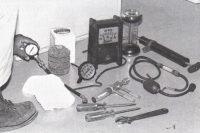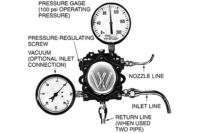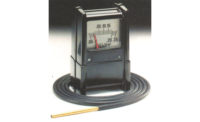Bob is a service technician who is well trained and nationally certified. However, he has sometimes suffered from the same confusion that all technicians occasionally do — the facts that he gathers may or may not point to the obvious cause of the problem or the best solution. But Bob has had something that no one else has. He recalled his long-time HVACR mentor and imagines him accompanying him as “Btu Buddy,” someone who reminded him to take time to stop and think before rushing to judgment, helping keep him on the right track, even with facts that are confusing.
Now, Bob’s company has promoted him to help train a new employee, right out of a school specializing in HVAC, just like Bob was. Bob is now Tim’s Btu Buddy. Tim is anxious to travel with Bob. Tim realizes that he is right out of school, with the theory and lab work that he accomplished in school, but still needs help. He knows that he worked with many of the components of the systems in the school, under ideal conditions with good light and air conditioning. Now it is into the field, sometimes under the house with poor lighting, or out on the rooftop in the sun, where the real action is. He is naturally and normally reluctant, but he has Bob to help guide him.
Bob and Tim were on their way to an oil heat service call. It is cold and the owner has no heat.
Tim asked, “How come there aren’t very many oil heat systems in our part of the country?”
Bob answered, “Oil heat can be very good heat, it can be economical, but many people live on the natural gas main lines and it is normally more economical in that case to use gas. Oil heat requires a tank to store the fuel and it requires someone to monitor the fuel level to make sure it doesn’t run out. Also, oil heat requires good service techniques and more attention than gas heat.”
Tim said, “I guess that propane (LPG) requires some of the same monitoring of the fuel level that oil heat does.”
Bob said, “Yes, propane is also a good heat but can cost more. You generally find oil heat and propane heat away from the gas mains, more in the country.”
Tim read the service ticket for today and said, “The owner says that the burner won’t burn and makes a sputtering sound for a few minutes and shuts off. Then he resets the button on the burner. Then the burner shuts off again after a few minutes. What do you think that means?”
Bob said, “I am not sure from here what is going on. I know that we should check the combustion chamber for excess fuel after the owner has reset the burner. We do not know how many times it has been reset and there may be too much fuel in the combustion chamber. We sure don’t want to fire the burner with too much fuel in the chamber. The first thing we will do is look in the chamber through the inspection door and take a rag and see if we can mop up any excess oil.”
Tim asked, “How long can the burner run and pump fuel after it has been reset before the pump and motor declare there is no flame?”
Bob responded, “The burner can try for about 90 seconds before it times out. If flame is not established within that 90 seconds, it shuts the system down. The question is how much has been pumped into the chamber. That is determined by how many times the owner resets the system. The owner usually doesn’t remember. The maximum number of times should be about three. If the burner doesn’t fire, the trouble should be found and repaired. When it is cold in the house, the owner becomes desperate and keeps resetting the safety switch hoping it will fix itself.”
They arrived and talked to the owner and Bob said, “Let’s check the combustion chamber and, if all is well, let’s reset it and see what that flame looks like.”
They looked over the system and concluded that the combustion chamber was clean and ready to fire the burner. Tim reset the burner safety switch and was observing the flame through the inspection door when he said, “Look at that flame. It is really funny looking.”
Bob looked and said, “It looks like it is full of water. It is partially burning, but this will not work.”
About that time, the safety shut the burner off.
Tim asked, “Now what?”
Bob said, “Let’s start by checking the oil filter and see what we see.”
They turned off the tank valve and removed the oil filter and found some water in the filter. Bob then said, “Let’s get the test kit for water and check the tank for water.”
They took the water test kit and went to the tank. Tim said, “I have never done this before; explain it to me please.”
Bob said, “This is an above ground tank and they are subject to collecting water over time. Sometimes people leave the fill cap off and some rain will get in the tank, but even if the cap has always been on the tank, the tank will collect water from sweating. This happens because of the change in temperature from night to day. During the daytime, the tank and oil warms up and the air in the tank expands and is pushed out. Then when night comes, the tank and oil cool down and the air shrinks and moist air moves into the tank and condenses into the oil (Figure 1). This water gathers in the bottom of the tank because it is heavier than the oil. We are going to take the tank measuring stick and put some paste from the test kit on the end of the stick and see if there is water and how much (Figure 2).”
They inserted the tank measuring stick and sure enough, there was water in the tank, about 4 inches of it.
Tim asked, “Are we going to have to change all of the oil in the tank?”
Bob said, “There are five ways that we can handle this and none of them require that we change the oil:
1. We can drop a pump inlet down to the bottom of the tank and pump out the water.
2. Sometimes there is a small valve in the bottom of the tank that can be opened to drain the water out in a bucket until we get oil and not water.
3. Sometimes you can raise the pickup tube for the oil above the water level. That is a temporary measure because the water will continue to rise. I would use that in really cold or bad weather only.
4. We could use a siphon hose and hand pump by keeping it well below the oil level. When we get the water flowing, we could disconnect the hand pump and let the oil flow by gravity.
5. Another thing we could do is loosen the drain plug in the bottom of the tank and let the water out. This has to be done carefully if there is a lot of oil in the tank. There will be pressure from the standing oil. If you take the plug all of the way out, you may get an oil and water bath. It may then be hard to restart the plug threads to stop the oil.
“I have used all of these methods with success.”
Tim asked, “Which method will we use?”
Bob said, “There are about 4 inches of water in the tank and about 20 inches of oil. That is probably several gallons of water. This tank does not have a drain valve. We only have a hand pump and I want to get the water out, so let’s use the siphon method.”
Tim went to the truck and brought back a 5-gallon bucket and the hand pump with some hoses to connect to the hand pump. They dropped one hose to the bottom of the tank and connected it to the hand pump inlet. The hose was long enough that the hand pump was well below the bottom of the tank. They worked the hand pump and got the water flowing and then disconnected the hand pump and the hose that was in the bottom of the tank continued the flow of water into the bucket. When the bucket was half full, they started seeing oil.
Bob said, “Raise the end of the hose and the flow will stop. We have all of the water out of the tank that we can get out. That is good. The next thing we should do is go to the oil pump and:
1. Loosen the flare nut at the filter inlet and let the water in the line run into the bucket, by gravity.
2. There is still some water in the line between the filter outlet and the pump inlet, so we will loosen the flare nut at the pump inlet and let any water that is in that line out.
3. We will then change the filter cartridge.
“We should also change the oil nozzle and run a combustion analysis on the furnace.”
They drained all of the water out of the lines from the tank to the pump inlet and changed the oil nozzle. They also removed the small fuel line from the pump to the burner and drained it.
Tim started the furnace and said, “The fire is still funny looking.”
Bob explained, “There is still some water in the pump and the fuel line behind the nozzle. It will clear out in a minute.”
The furnace flame cleared up and they allowed the furnace to run until it got up to temperature. They then ran a combustion analysis and determined that the furnace was operating at 74 percent efficiency.
Tim asked, “Will you explain the combustion process and analysis to me again? I seem to have forgotten some of the steps and reasons for the steps.”
Bob said, “We will save that for another conversation. You have had enough for now.”
Publication date: 2/17/2014
Want more HVAC industry news and information? Join The NEWS on Facebook, Twitter, and LinkedIn today!












